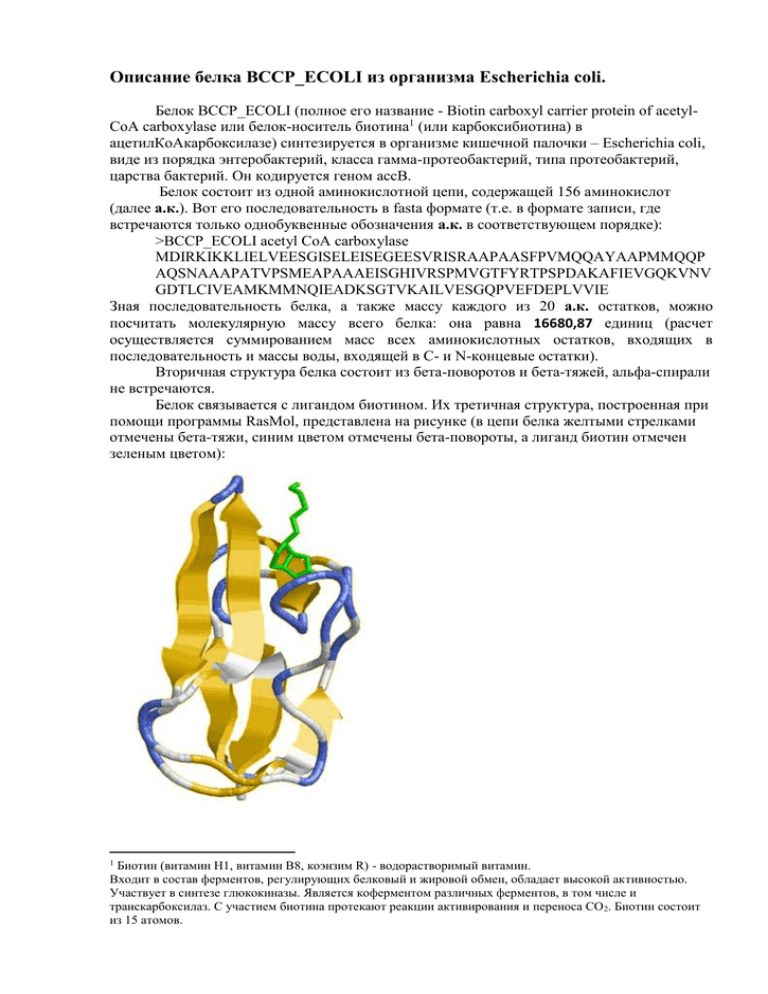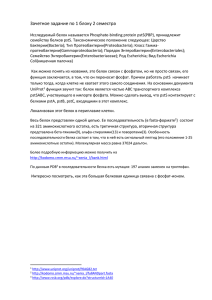Файл с характеристикой белка BCCP
реклама

Описание белка BCCP_ECOLI из организма Escherichia coli. Белок BCCP_ECOLI (полное его название - Biotin carboxyl carrier protein of acetylCoA carboxylase или белок-носитель биотина1 (или карбоксибиотина) в ацетилКоАкарбоксилазе) синтезируется в организме кишечной палочки – Escherichia coli, виде из порядка энтеробактерий, класса гамма-протеобактерий, типа протеобактерий, царства бактерий. Он кодируется геном accB. Белок состоит из одной аминокислотной цепи, содержащей 156 аминокислот (далее а.к.). Вот его последовательность в fasta формате (т.е. в формате записи, где встречаются только однобуквенные обозначения а.к. в соответствующем порядке): >BCCP_ECOLI acetyl CoA carboxylase MDIRKIKKLIELVEESGISELEISEGEESVRISRAAPAASFPVMQQAYAAPMMQQP AQSNAAAPATVPSMEAPAAAEISGHIVRSPMVGTFYRTPSPDAKAFIEVGQKVNV GDTLCIVEAMKMMNQIEADKSGTVKAILVESGQPVEFDEPLVVIE Зная последовательность белка, а также массу каждого из 20 а.к. остатков, можно посчитать молекулярную массу всего белка: она равна 16680,87 единиц (расчет осуществляется суммированием масс всех аминокислотных остатков, входящих в последовательность и массы воды, входящей в С- и N-концевые остатки). Вторичная структура белка состоит из бета-поворотов и бета-тяжей, альфа-спирали не встречаются. Белок связывается с лигандом биотином. Их третичная структура, построенная при помощи программы RasMol, представлена на рисунке (в цепи белка желтыми стрелками отмечены бета-тяжи, синим цветом отмечены бета-повороты, а лиганд биотин отмечен зеленым цветом): Биотин (витамин Н1, витамин B8, коэнзим R) - водорастворимый витамин. Входит в состав ферментов, регулирующих белковый и жировой обмен, обладает высокой активностью. Участвует в синтезе глюкокиназы. Является коферментом различных ферментов, в том числе и транскарбоксилаз. С участием биотина протекают реакции активирования и переноса СО 2. Биотин состоит из 15 атомов. 1 Белок содержит 1 биотинилсвязывающий домен, располагающийся на участке с 81 по 155 а.к. в последовательности белка. Связывание белка и биотина происходит на 122 а.к., так что мутация в этой а.к. может привести к нарушению функции белка. В бактерии белок является компонентом ацетилКофермента А в комплексе карбоксилазы; сначала биотинкарбоксилаза катализирует карбоксилизацию белканосителя, затем транскарбоксилаза переносит карбоксильную группу, чтобы сформировать малонилКоА. Таким образом, BCCP_ECOLI катализирует синтез малонилаКоА, первого посредника в синтезе жирных кислот. Подробные данные об этом белке можно найти в различных базах данных: запись в базе UniProt, она же в текстовом виде (в ней он числится под идентификационным номером BCCP_ECOLI, под несколькими кодами доступа (наиболее распространенный – P0ABD8)), запись в PDB (запись 1bdo). При поиске информации о белке также были найдены статьи о нем и его функциях в бактерии. Вот некоторые из них (приведены аннотации, найденные в базе данных UniProt): Название: Ген, кодирующий подгруппу биотинкарбоксилазы в ацетилКоАкарбоксилазе кишечной палочки. Авторы: Li S.-J., Cronan J.E. Jr. Аннотация:We report the molecular cloning and DNA sequence of the gene encoding the biotin carboxylase subunit of Escherichia coli acetyl-CoA carboxylase. The biotin carboxylase gene encodes a protein of 449 residues that is strikingly similar to amino-terminal segments of two biotin-dependent carboxylase proteins, yeast pyruvate carboxylase and the alpha-subunit of rat propionyl-CoA carboxylase. The deduced biotin carboxylase sequence contains a consensus ATP binding site and a cysteine-containing sequence preserved in all sequenced bicarbonate-dependent biotin carboxylases that may play a key catalytic role. The gene encoding the biotin carboxyl carrier protein (BCCP) subunit of acetyl-CoA carboxylase is located upstream of the biotin carboxylase gene and the two genes are cotranscribed. As previously reported by others, the BCCP sequence encoded a protein of 16,688 molecular mass. However, this value is much smaller than that (22,500 daltons) obtained by analysis of the protein. Amino-terminal amino acid sequencing of the purified BCCP protein confirmed the deduced amino acid sequence indicating that BCCP is a protein of atypical physical properties. Northern and primer extension analyses demonstrate that BCCP and biotin carboxylase are transcribed as a single mRNA species that contains an unusually long untranslated leader preceding the BCCP gene. We have also determined the mutational alteration in a previously isolated acetyl-CoA carboxylase (fabE) mutant and show the lesion maps within the BCCP gene and results in a BCCP species defective in acceptance of biotin. Translational fusions of the carboxyl-terminal 110 or 84 (but not 76) amino acids of BCCP to beta-galactosidase resulted in biotinated beta-galactosidase molecules and production of one such fusion was shown to result in derepression of the biotin biosynthetic operon. Название: Повышение скорости регуляции ацетилКоАкарбоксилазы, катализирующей первый важный шаг в биосинтезе липидов, в кишечной палочке. Авторы: Li S.-J., Cronan J.E.Jr. Аннотация: Acetyl coenzyme A (CoA) carboxylase catalyzes the synthesis of malonylCoA, the first intermediate of fatty acid synthesis. The Escherichia coli enzyme is encoded by four subunits located at three different positions on the E. coli chromosome. The accBC genes lie in a small operon at min 72, whereas accA and accD are located at min 4.3 and 50, respectively. We examined the expression of the genes that encode the E. coli acetyl-CoA carboxylase subunits (accA, accBC, and accD) under a variety of growth conditions by quantitative Northern (RNA) blot analysis. We found a direct correlation between the levels of transcription of the acc genes and the rate of cellular growth. Consistent results were also obtained upon nutritional upshift and downshift experiments and upon dilution of stationary-phase cultures into fresh media. We also determined the 5' end of the accA and accD mRNAs by primer extension and did transcriptional fusion analysis of the previously reported accBC promoter. Several interesting features were found in the promoter regions of these genes, including a bent DNA sequence and an open reading frame within the unusually long leader mRNA of the accBC operon, potential stem-loop structures in the accA and accD mRNA leader regions, and a stretch of GC-rich sequences followed by AT-rich sequences common to all three promoters. In addition, both accA and accD are located in complex gene clusters. For example, the accA promoter was localized within the upstream polC gene (which encodes the DNA polymerase III catalytic subunit), suggesting that additional regulatory mechanisms exist. Название: АцетилКоАкарбоксилаза из кишечной палочки: организация гена и нуклеотидная последовательность подгруппы биотинкарбоксилазы. Авторы: Kondo H., Shiratsuchi K., Yoshimoto T., Masuda T., Kitazono A., Tsuru D., Anai M., Sekiguchi M., Tanabe T. Аннотация: Biotin carboxylase [biotin-carboxyl-carrier-protein: carbon-dioxide ligase (ADP-forming), EC 6.3.4.14] is the enzyme mediating the first step of the acetyl-CoA carboxylase [acetyl-CoA:carbon-dioxide ligase (ADP-forming), EC 6.4.1.2] reaction. We screened an Escherichia coli DNA library and a DNA fragment carrying the biotin carboxylase gene fabG, and its flanking regions were cloned. The gene for biotin carboxyl carrier protein was found 13 base pairs upstream of the fabG gene. Nucleotide sequencing of the recombinant plasmids revealed that the fabG codes for a 449-amino acid residue protein with a calculated molecular weight of 49,320, a value in good agreement with that of 51,000 determined by SDS/polyacrylamide gel electrophoresis of the purified enzyme. The deduced amino acid sequence of biotin carboxylase is also consistent with the partial amino acid sequence determined by Edman degradation. The primary structure of this enzyme exhibits a high homology with those of other biotin-dependent enzymes and carbamoyl-phosphate synthetase [carbon-dioxide:L-glutamine amino-ligase (ADP-forming, carbamate-phosphorylating), EC 6.3.5.5]; therefore, all these enzymes probably function through the same mechanism of reaction.
